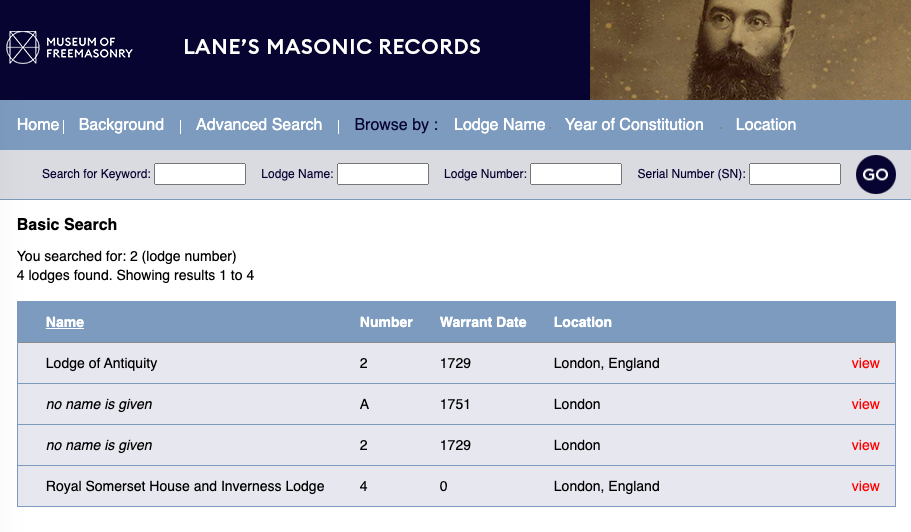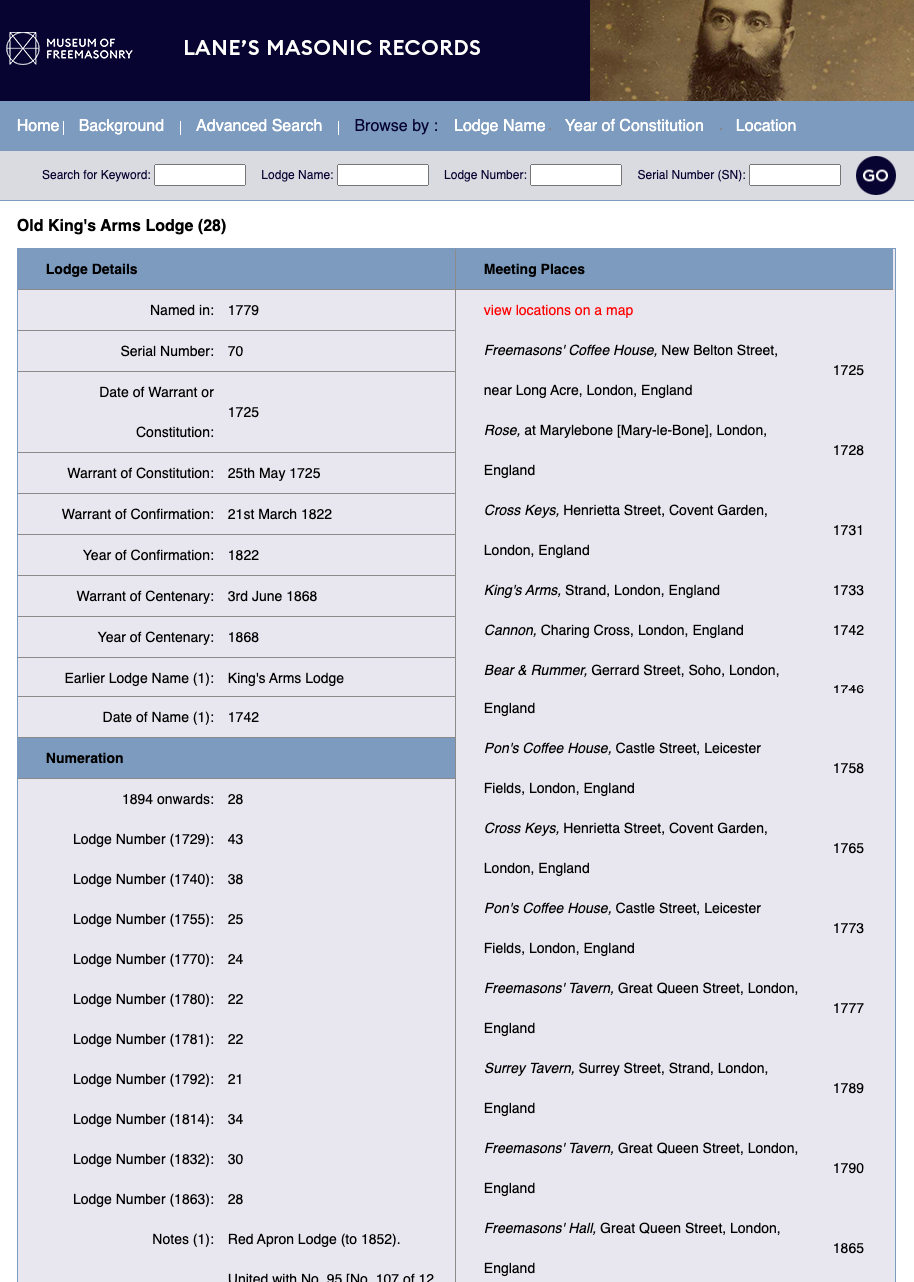Basic searching
Basic searches can be carried out from all pages of Lane online by using one of the four search boxes at the top of the page. A search can be made for Keywords, which will search for words in the name or meeting places of lodges; Lodge name; Lodge number, which will search for any lodge that used that number and Serial Number. Serial Numbers are unique numbers that were allocated to lodges by Museum of Freemasonry to rank lodges in date order. The results of a basic search will be displayed as a list of lodges that fit the criteria of that search. For example, a search for Lodge Number 2 produced this result, a list of lodges whose number was at one time 2.

To look at an individual lodge’s record, click on the view link.
How to read a lodge record
A lodge record begins with the current name of the lodge e.g. Old King’s Arms Lodge (28). The lodge number is recorded in the brackets. If the lodge had stopped meeting before the publication of the original Lane’s in 1894 its number is not recorded next to its name.
Lodge records are divided into three categories; Lodge Details, Meeting Places and Numeration.

Lodge Details
Named in: The year a lodge was given its current name
Serial Number: A unique number allocated to the lodge by the Library and Museum of Freemasonry.
Red Apron: The lodge is privileged to nominate a Steward for the Grand Festival of the United Grand Lodge of England.
Date of Warrant or Constitution: The year in which the lodge came into being by being granted a warrant by one of the English Grand Lodges. Warrants are a lodge’s authority to meet and must be displayed during a lodge meeting.
Warrant of Constitution: The date that the warrant was granted.
Warrant of Confirmation: Lodges whose warrant is lost or destroyed have to apply for a warrant of confirmation as a replacement.
Year of Confirmation: The year in which a warrant of confirmation was issued.
Centenary Warrant: Lodges who are issued with centenary warrant have one hundred years of continuous working and their members are entitled to wear a Centenary Jewel.
Year of Centenary: The year in which a centenary warrant was issued.
Earlier Lodge Name: A previous name of a lodge. Some lodges will have had a number of names over their history, so names are listed chronologically.
Date of name: The year in which a previous name was first used.
Freemasons Medal and Date of Freemasons Medal: This records if a lodge qualified for a Hall Medal by lending the Premier or Moderns Grand Lodge of England £25 to help pay off the costs incurred by the building of the first Freemasons’ Hall in 1776. The medal was first issued in 1780.
Hall Stone Medal: Lodges that donated an average of ten guineas per head towards the building costs of the current Freemasons’ Hall between 1921 and 1933 qualified as Hall Stone Lodges entitling the lodge’s Master to wear a Hall Stone Jewel attached to his Master’s collar.
Special Medal: Some lodges have been given special permission by a Past Grand Master for their members to wear a special jewel denoting their membership of the lodge.
Not all of these sub-categories will appear in every lodge record, only those relevant to a particular lodge. Please note that lodges that appeared in the printed version of Lane in 1894 have not yet been updated to carry details relating to the lodge after 1894. These will be added at a later date.
Meeting Places
This category lists the meeting places of a lodge in chronological order as they appeared in the records of the various English Grand Lodges. The meeting places can be viewed on a map but the accuracy of the map cannot be guaranteed due to the change of place names over time. Please note that lodges that appeared in the original printed version of Lane in 1894 only have their locations listed up until that date. Further meeting places will be added in the future.
Numeration
This records the numeration of a lodge. The Premier of Moderns Grand Lodge (1717-1813) renumbered its lodges in 1729, 1740, 1755, 1770, 1780, 1781 and 1792 essentially to fill up gaps left by lodges erased from their roll.
The Antients or Athol Grand Lodge (1752-1813) did not renumber their lodges but they did re-issue old numbers to new lodges. In the numeration section a Lodge Number (A) heading indicates that the lodge was originally part of the Antients Grand Lodge.
After the Union of the two Grand Lodges in 1813 a new list was created of lodges under the United Grand Lodge of England. This merger and renumbering was published in 1814. The United Grand Lodge of England renumbered in 1832 and in 1863. Lodges that were created after 1863 are allocated a number from the 1863 re-numbering.
Erased: If a lodge has been removed from the roll of lodges it is said to be erased. This can mean that the lodge has ceased to exist but it can also mean that the lodge has joined a different Grand Lodge. This would be explained in an additional note. For example; Stirling Lodge No. 1001 was warranted by the United Grand Lodge of England in 1857 to meet at Stirling in Ontario, Canada. It returned its warrant on 27th November 1857 and was erased from the roll. However, it had continued under a new warrant as Stirling Lodge No. 69 on the registers of the Grand Lodge of Canada in Ontario.

